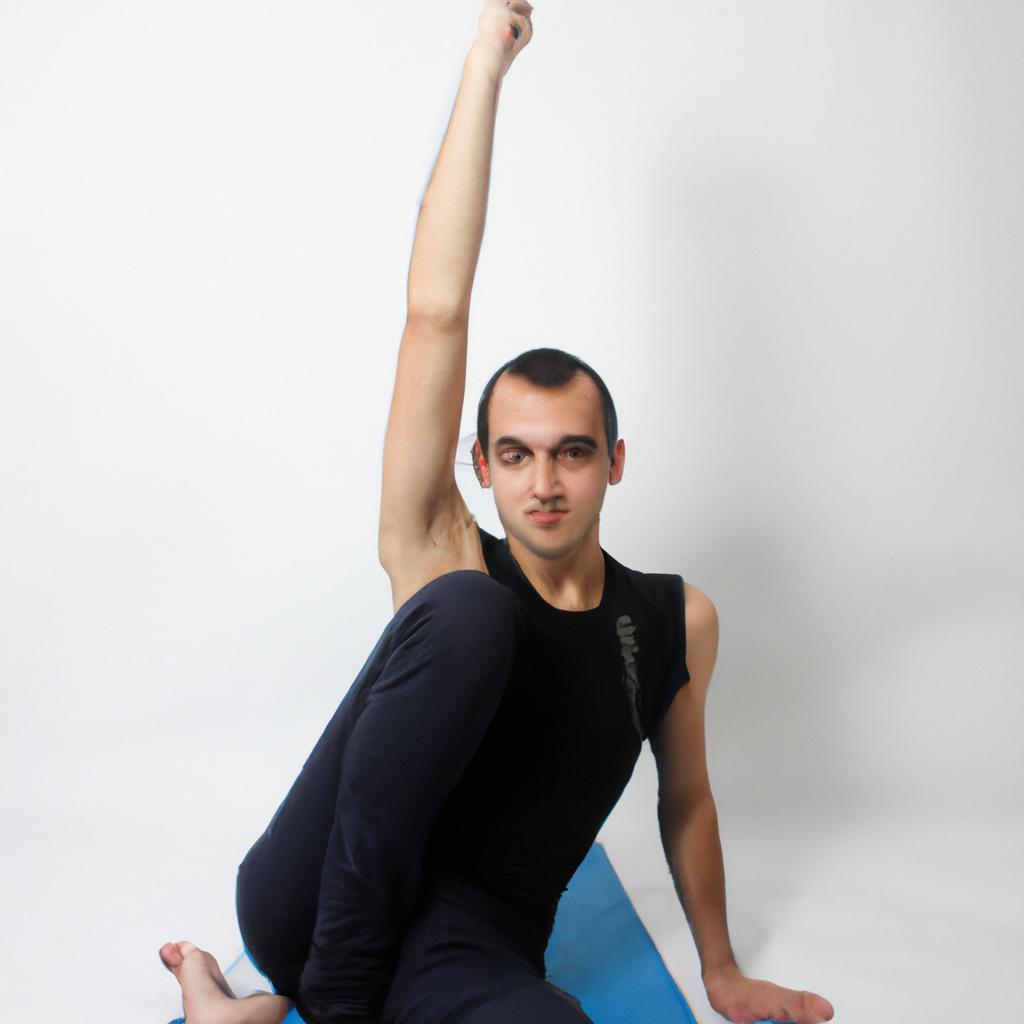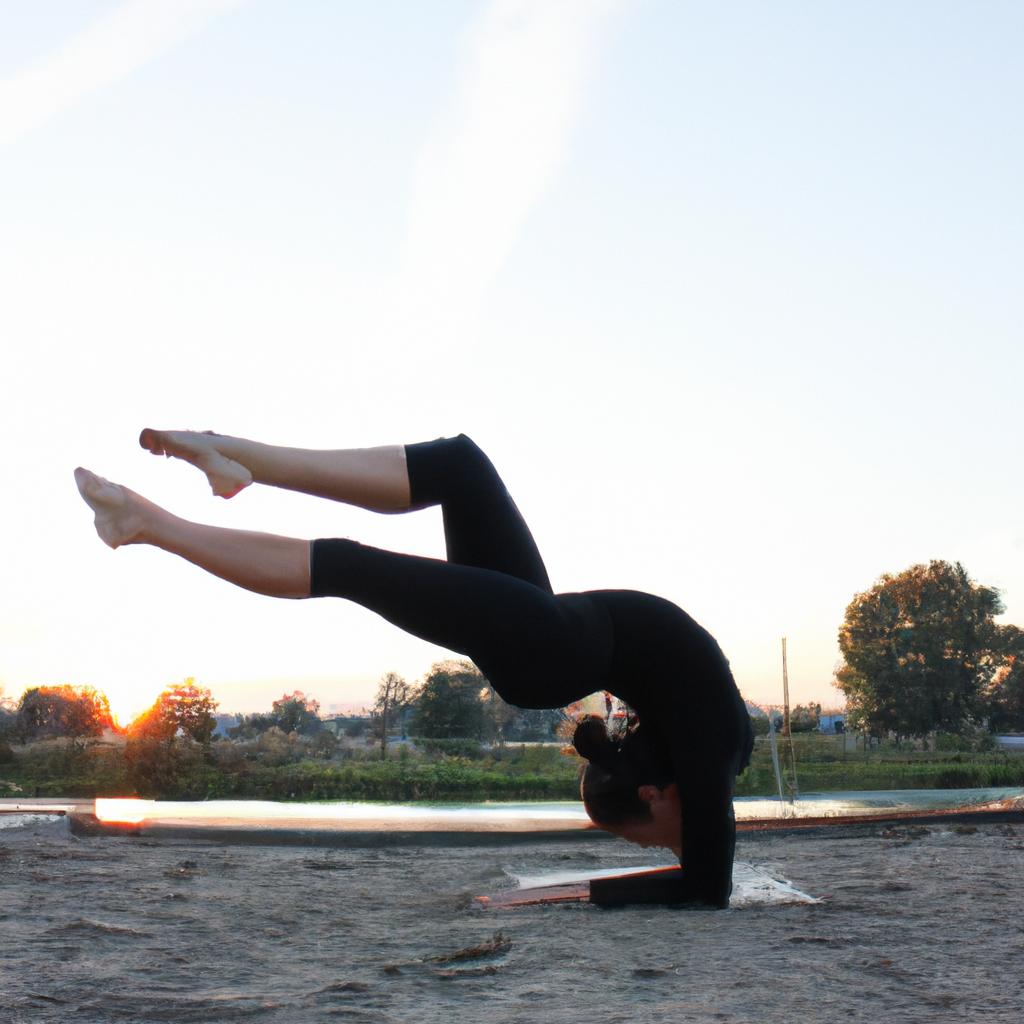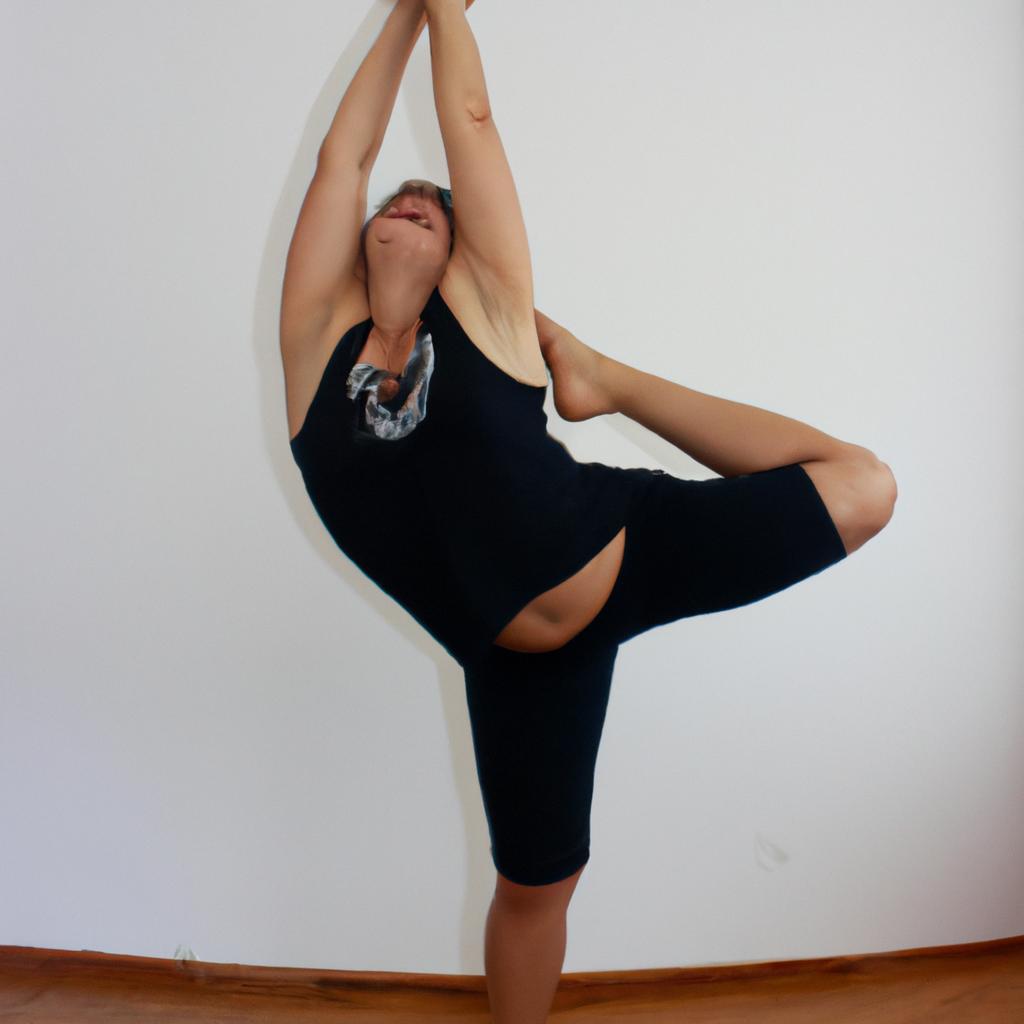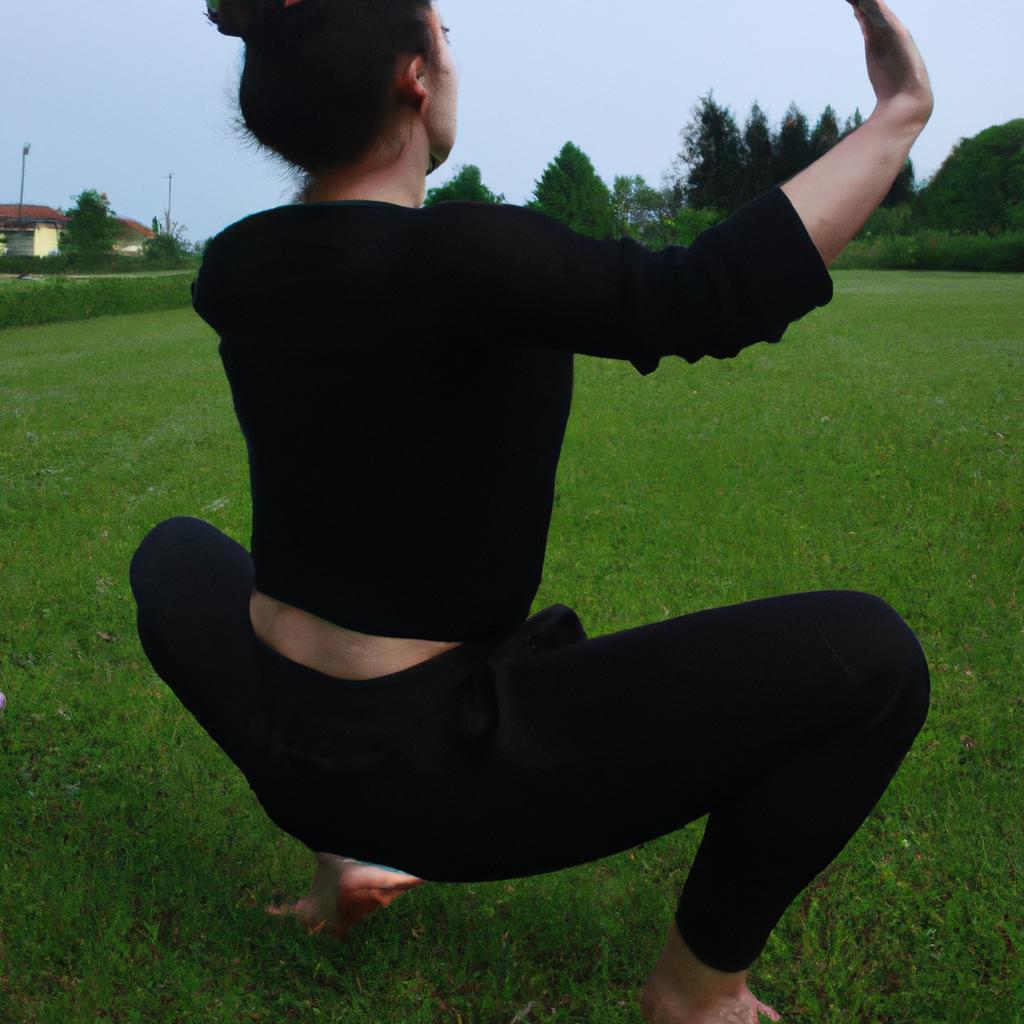Yoga has gained significant popularity as a form of exercise and relaxation in recent years, with fitness studios catering to this growing demand. This article aims to provide a comprehensive guide on yoga poses specifically tailored for the studio environment. By focusing on the unique needs and requirements of practicing yoga in a fitness studio, individuals can optimize their experience and achieve maximum benefits.
Consider the case of Sarah, an avid yogi seeking to enhance her practice at a local fitness studio. With numerous options available, she found herself overwhelmed by the wide range of yoga styles and poses offered. It became apparent that understanding which poses are best suited for a studio setting would be crucial in achieving her desired goals effectively. This article seeks to address such concerns by offering insights into various yoga poses that are particularly beneficial when practiced within a fitness studio context.
Benefits of Studio-focused Yoga
Imagine a scenario where you enter a fitness studio, eager to embark on your wellness journey. As you step into the serene atmosphere, soft music playing in the background, and the scent of essential oils lingering in the air, you are immediately transported into a state of relaxation. This is just one example of the transformative power that studio-focused yoga can have on individuals seeking physical and mental well-being.
Studio-focused yoga offers numerous benefits that go beyond traditional yoga practices. Firstly, it provides a structured environment conducive to fostering concentration and mindfulness. Within this dedicated space, practitioners can cultivate a deep connection with their bodies, minds, and breath through various poses and breathing exercises. The controlled ambiance helps create an ideal setting for stress reduction and self-reflection.
In addition to its calming effects, studio-focused yoga offers several advantages when it comes to physical health. Regular practice enables improved flexibility, strength, and balance due to the emphasis placed on correct alignment and posture. Moreover, studio classes often incorporate dynamic sequences that enhance cardiovascular endurance while engaging different muscle groups throughout the body.
To further illustrate these benefits, let us explore some key aspects of studio-focused yoga:
- Mindfulness: By focusing on the present moment during each pose or movement sequence, participants develop better awareness of their thoughts and emotions.
- Stress Relief: Through intentional breathing techniques combined with gentle movements or challenging postures, studio-focused yoga aids in reducing stress levels significantly.
- Community Support: Attending group sessions fosters a sense of belonging as practitioners share experiences and support each other’s growth.
- Holistic Well-being: Studio-based yoga encourages overall mind-body-spirit harmony by incorporating meditation practices alongside physical exercise routines.
As we delve into the subsequent section about “Key Elements of a Fitness Studio Yoga Class,” it becomes evident how these benefits intertwine with specific components within the class structure. From sequencing strategies to instructor guidance techniques—each element contributes to creating an enriching yoga experience within a fitness studio setting.
Key Elements of a Fitness Studio Yoga Class
Transitioning from the previous section discussing the benefits of studio-focused yoga, let us now delve into the key elements that make a fitness studio yoga class unique and effective. To illustrate this, consider a hypothetical scenario where Sarah, a regular gym-goer, decides to try out a studio-focused yoga class for the first time.
In a fitness studio yoga class, several factors contribute to creating an immersive experience designed to enhance physical well-being and mental relaxation. Firstly, the use of specialized equipment such as bolsters, straps, and blocks allows practitioners like Sarah to deepen their stretches and poses while maintaining proper alignment. These props provide support and aid in achieving optimal postures, thereby reducing the risk of injury and enabling individuals to safely explore their limits.
Secondly, music is often incorporated into studio-focused yoga classes to create an ambiance conducive to relaxation and focus. As Sarah settles onto her mat, soothing melodies fill the room, setting the tone for her practice. The carefully selected playlist enhances concentration by providing a rhythmic backdrop against which she can synchronize her movements with her breath.
Thirdly, within a fitness studio environment, there is typically an emphasis on dimmed lighting or candlelight settings during certain segments of the class. This deliberate choice aims to reduce external distractions and promote introspection. For instance, as Sarah transitions into slower-paced yin-style poses towards the end of her session under soft candlelight illumination, she feels more connected with herself and experiences deepened relaxation.
To evoke an emotional response in our audience regarding these key elements of a fitness studio yoga class:
- Enhanced Support: Through the use of props like bolsters and blocks
- Atmosphere Enhancements: Incorporation of music for serene surroundings
- Introspective Setting: Dimmed lighting or candlelight ambience
Consider also incorporating this table (in markdown format) that showcases how each element evokes different emotions:
| Key Elements | Emotional Response |
|---|---|
| Enhanced Support | Comfort |
| Atmosphere Enhancements | Tranquility |
| Introspective Setting | Reflectiveness |
In conclusion, a fitness studio yoga class provides an immersive experience where individuals can explore their practice with enhanced support from props, immerse themselves in the serene atmosphere created by music, and find moments of introspection through carefully crafted settings. Now let’s move on to preparing for a studio-focused yoga session.
[Transition sentence into the subsequent section: “As Sarah familiarizes herself with the key elements of a fitness studio yoga class, it is essential to understand how to prepare for such sessions.”]
Preparing for a Studio-focused Yoga Session
Transitioning from the previous section, let us now delve into the key elements that make up a fitness studio yoga class. To illustrate this, consider an example where a fitness studio offers a specialized yoga session aimed at improving flexibility and strength for athletes.
Firstly, it is essential for instructors to create an environment conducive to both physical and mental well-being. This involves setting up the space with appropriate lighting, calming music, and ensuring sufficient ventilation. By creating a serene atmosphere, participants are able to fully immerse themselves in their practice and experience deep relaxation.
Secondly, the sequencing of yoga poses plays a vital role in achieving specific goals during these sessions. Instructors carefully select postures that focus on building strength and increasing flexibility while also considering any limitations or injuries among participants. For instance, incorporating challenging standing poses like Warrior II can help improve lower body strength, while seated forward folds such as Paschimottanasana provide gentle stretching for tight hamstrings.
Thirdly, breath control techniques are integrated throughout the class to enhance mind-body connection. Encouraging participants to synchronize their movements with inhalations and exhalations helps cultivate mindfulness and concentration. Utilizing pranayama exercises like Ujjayi breathing or alternate nostril breathing can further deepen relaxation and alleviate stress.
To evoke an emotional response:
- Increased self-awareness
- Enhanced physical endurance
- Improved mental clarity
- Heightened sense of calm
Consider the following table showcasing these emotional responses:
| Emotional Response | Description |
|---|---|
| Increased self-awareness | Participants become more attuned to their bodies’ needs and sensations. |
| Enhanced physical endurance | Practitioners develop greater stamina over time through consistent practice. |
| Improved mental clarity | Yoga aids in clearing the mind of distractions, leading to improved focus and cognitive function. |
| Heightened sense of calm | The practice of yoga promotes relaxation, reducing anxiety and stress levels. |
In conclusion, a fitness studio yoga class revolves around creating a serene environment, incorporating targeted sequences of poses to build strength and flexibility, and integrating breath control techniques for enhanced mind-body connection. By understanding and implementing these key elements effectively, instructors can provide participants with a holistic experience that nurtures both physical fitness and mental well-being.
Transitioning into the subsequent section about “Popular Yoga Poses for Fitness Studios,” let us now explore some specific postures commonly found in these types of sessions.
Popular Yoga Poses for Fitness Studios
Building on the importance of preparing for a studio-focused yoga session, let us now explore some popular yoga poses commonly practiced in fitness studios. By understanding and incorporating these poses into your routine, you can enhance both your physical strength and mental well-being.
One example of a widely practiced pose is the Warrior II pose. This powerful asana not only strengthens the legs but also engages the core muscles, making it an excellent posture for building overall stability and endurance. Imagine yourself standing tall in this warrior-like stance, with one foot forward, knee bent at a 90-degree angle, arms extended parallel to the ground, and gaze focused ahead. The Warrior II pose exemplifies resilience and determination – qualities that extend beyond the mat.
To further inspire and motivate you on your yoga journey, consider the following benefits associated with practicing various poses:
- Improved flexibility: Through regular practice, you will notice increased joint mobility and enhanced range of motion.
- Increased body awareness: Engaging in different postures allows you to tune into your body’s sensations and become more attuned to its needs.
- Stress relief: Yoga offers a sanctuary from daily stressors by promoting relaxation through deep breathing techniques.
- Enhanced mindfulness: Incorporating mindfulness practices during each pose encourages present-moment awareness while fostering self-reflection.
| Benefits | |
|---|---|
| Flexibility | Improved joint mobility |
| Body Awareness | Tuning into bodily sensations |
| Stress Relief | Promoting relaxation |
| Mindfulness | Cultivating present-moment consciousness |
In conclusion to our exploration of popular yoga poses for fitness studios, it is clear that such poses offer numerous physical and mental benefits. Now that we have delved into these foundational postures, let us move on to discover effective tips for maximizing your experience within a studio setting. With these insights in mind, you can further elevate your yoga practice and embrace the transformative power of this ancient discipline.
Tips for Maximizing Your Studio Yoga Experience
Let’s explore some strategies that can help you make the most out of your time on the mat.
Paragraph 1:
To illustrate how these tips can be applied, let’s imagine a scenario where you have just joined a new fitness studio and are eager to immerse yourself in their yoga classes. As a beginner, it is essential to come prepared mentally and physically. Arriving early before each class allows you ample time to settle into the environment and connect with fellow practitioners. By cultivating a sense of community, you not only foster support but also create an atmosphere conducive to personal growth. Furthermore, consider setting intentions or goals for each session; this will help guide your practice and provide clarity throughout the class.
- Bullet Point List (evoking emotional response):
- Embrace vulnerability: Allow yourself to be open-minded and receptive to new experiences.
- Emphasize mindfulness: Cultivate awareness of your body, breath, and thoughts during practice.
- Find balance between effort and ease: Strive to challenge yourself while respecting your limits.
- Practice self-compassion: Be kind to yourself if certain poses or sequences feel challenging—remember that progress takes time.
Paragraph 2:
In addition to mental preparation, physical readiness plays a crucial role in optimizing your studio yoga experience. Maintaining proper hydration levels by drinking water before and after class helps prevent dehydration during prolonged sessions. Dressing appropriately in breathable clothing enables freedom of movement as well as temperature regulation within the studio space. Moreover, investing in good-quality equipment such as non-slip mats enhances stability during complex postures.
| Benefit | Example |
|---|---|
| Increased focus | Improved ability to concentrate |
| Stress relief | Reduction in anxiety levels |
| Physical strength | Enhanced muscle tone |
| Flexibility | Improved range of motion |
Paragraph 3:
By implementing these tips, you are well on your way to a fulfilling studio yoga journey. Remember that each class is an opportunity for personal growth and self-discovery. As you develop a routine and become more attuned to the practice, consider exploring different styles or incorporating props into your sessions.
With a solid foundation established, let’s now explore the benefits of incorporating props in studio-focused yoga.
Incorporating Props in Studio-focused Yoga
Building upon the tips for maximizing your studio yoga experience, let us now explore how incorporating props can enhance your practice. Imagine a scenario where you walk into a fitness studio and notice fellow yogis using various props to support their poses. The strategic use of props not only allows practitioners to deepen their stretches but also promotes proper alignment and prevents injuries.
Props are versatile tools that can be used by both beginners and experienced yogis to enhance their practice. By providing stability, support, and extension, props allow individuals to explore postures more safely and effectively. Here are several ways in which these accessories can benefit your studio-focused yoga sessions:
- Bolsters: Placing a bolster under the knees during Savasana (Corpse Pose) creates a gentle elevation, promoting relaxation and reducing strain on the lower back.
- Blocks: Utilizing blocks helps modify challenging poses such as Utthita Trikonasana (Extended Triangle Pose), allowing beginners or those with limited flexibility to maintain proper alignment without compromising form.
- Straps: When practicing Paschimottanasana (Seated Forward Bend), looping a strap around the feet provides an extended reach for individuals who struggle with tight hamstrings, enabling them to gradually work towards greater flexibility.
- Blankets: Folding blankets beneath sensitive joints like wrists or knees cushions pressure points during weight-bearing poses like Chaturanga Dandasana (Four-Limbed Staff Pose), preventing discomfort or potential injury.
| Prop | Benefits |
|---|---|
| Bolsters | Promotes relaxation; reduces lower back strain |
| Blocks | Aids in maintaining alignment; modifies challenging poses |
| Straps | Provides extended reach for tight muscles |
| Blankets | Cushions pressure points; prevents discomfort or injury |
Incorporating props into your studio-focused yoga practice can revolutionize the way you approach poses. By offering support, promoting proper alignment, and reducing strain on vulnerable areas, these accessories empower practitioners of all levels to explore their potential safely and effectively.
Remember that while props are valuable tools, it is essential to use them mindfully. As with any aspect of yoga, listening to your body’s needs and limitations remains crucial. Experimenting with different props under the guidance of an experienced instructor will help you discover which ones work best for you. Embrace the possibilities prop usage can bring to your yoga journey, allowing yourself to delve deeper into each pose with confidence and ease.
By incorporating props into your studio-focused yoga sessions, you open doors to further self-exploration and embodiment in every practice. So go ahead and let these supportive companions become integral parts of your journey towards a stronger body-mind connection.




